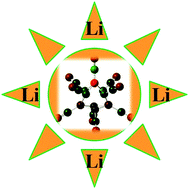Role of ligands in the stability of BnXn and CBn−1Xn (n = 5–10; X = H, F, CN) and their potential as building blocks of electrolytes in lithium ion batteries†
Abstract
Stabilizing small multiply charged negative ions in the gas phase has been of considerable interest in recent years. B12H122− is one of the most well-known dianions which is stable against auto-detachment of its second electron in the gas phase by 0.9 eV, whereas BnHn2− with n < 12 is unstable. Using density functional theory, we have examined systematically the role of ligands in stabilizing smaller mono- and di-anions of BnXn and CBn−1Xn (n = 5–10; X = H, F, CN). We show that the stability of the negative ions of these complexes increases with the electron affinity of the ligand and Bn(CN)n2− can even be stable against electron emission for n ≥ 5. We also show that CBn−1(CN)n2− is stable against electron emission for n ≥ 8, even though these moieties contain one electron more than needed to satisfy the Wade–Mingos rule. We have examined the potential of these stable negative ions as building blocks of electrolytes in Li-ion batteries. By calculating the binding energies between the CBn−1Xn1−,2− and Li+, we find that some of these clusters may even outperform CB11H12− as electrolytes in metal-ion batteries.



 Please wait while we load your content...
Please wait while we load your content...